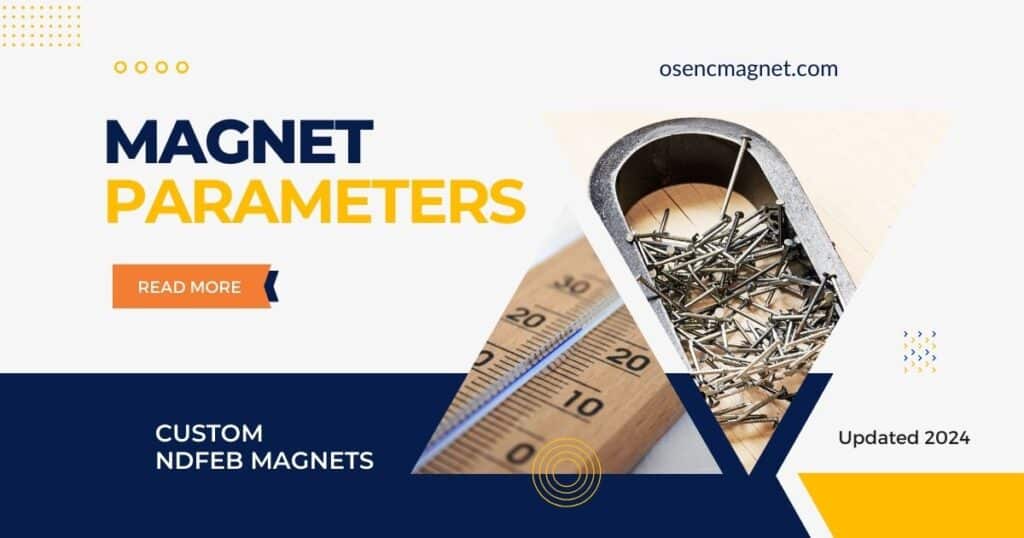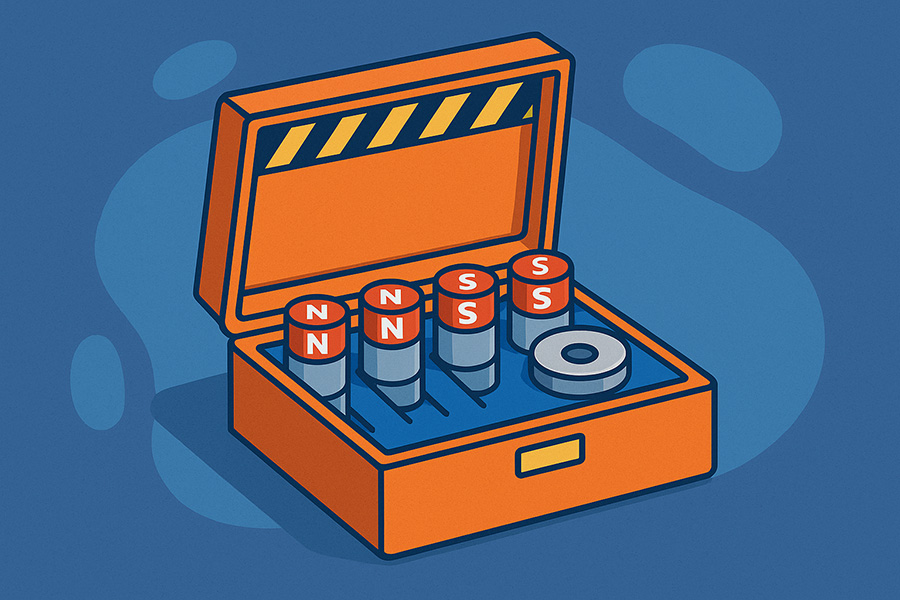In this guide, we’ll walk through the essential parameters that determine neodymium magnet quality and performance.
This knowledge will help you make informed purchasing decisions.
Table of Contents
Understanding Neodymium Magnets
Neodymium magnets (Nd-Fe-B) were developed in the 1980s by General Motors and Sumitomo.
- These magnets contain an alloy of neodymium, iron, and boron with a crystal structure of Nd₂Fe₁₄B.
What makes these magnets special?
- They can produce a magnetic field of 1.0-1.4 teslas.
- This incredible strength allows them to lift over 1,000 times their own weight!
- For perspective, neodymium magnets have a magnetic strength about 18 times greater than traditional ferrite magnets by volume.
A tiny neodymium magnet can replace a much larger ferrite magnet while delivering better performance.
Below, we will list 10 essential parameters that define quality and performance of neodymium magnets.
1. Remanence (Br) – The Power Factor
Remanence measures the magnetic strength that remains after the external magnetizing field disappears.
Higher Br values mean stronger magnets.
Typical values
Neodymium magnets have very high remanence, typically 1.1-1.3 teslas (up to 1.4T for highest grades).
For comparison, ferrite magnets have only 0.2-0.7T.
What this means for you
A magnet with higher remanence will exert more pulling force.
It generates stronger fields for the same size.
For projects needing maximum strength in minimal space, choose magnets with higher Br values.
2. Coercivity (Hc) – The Resistance Factor
Coercivity tells us how well a magnet resists demagnetization from opposing magnetic fields.
- Think of it as the magnet’s defensive capability.
Typical values
Neodymium magnets exhibit exceptionally high coercivity, typically 750-2000 kA/m (or about 9-25 kOe).
This is much higher than older magnets like Alnico, which can have coercivity below 50 kA/m.
What this means for you
Magnets with higher coercivity maintain performance better when working near other magnets.
- They resist losing strength when exposed to opposing fields.
- This matters particularly in motors, generators, and complex magnetic assemblies.
A high coercivity indicates the magnet can withstand strong opposing fields without becoming demagnetized.
3. Intrinsic Coercivity (Hci) – The Stability Factor
Intrinsic coercivity measures resistance to complete demagnetization.
It’s like the magnet’s ultimate defense system.
Typical values
The intrinsic coercivity of neodymium magnets is typically 750-2000 kA/m, depending on grade.
Grade indicators
Neodymium magnets are engineered with different coercivity grades denoted by letters like H, SH, UH, and EH.
These ensure adequate resistance to demagnetization at various operating temperatures.
What this means for you
Higher Hci values indicate magnets that withstand harsh conditions better.
They maintain performance in high-temperature environments.
- For applications with heat exposure or strong opposing fields, prioritize high Hci values.
4. Maximum Energy Product (BH)max – The Efficiency Factor
This parameter shows the maximum energy density the magnet can store.
It’s measured in MGOe or kJ/m³.
Typical values
Neodymium magnets have the highest energy product of any magnetic material today—typically 250-440 kJ/m³ (approximately 30-55 MGOe) for sintered Nd-Fe-B.
Impressive comparison
This energy density is about 18 times greater than typical ferrite magnets by volume!
Grade classification
Neodymium magnet grades are classified by their BHmax value (e.g., N35, N52). N52 corresponds to approximately 52 MGOe.
- Higher grades are stronger but often more expensive or have lower temperature ratings.
What this means for you
Higher (BH)max values indicate more powerful magnets for their size.
They deliver more magnetic energy from smaller volumes.
- When space is limited but performance can’t be compromised, look for high (BH)max ratings.
5. Temperature Performance – The Durability Factor
Neodymium magnets have two critical temperature specifications:
Curie Temperature (Tc)
The point where a magnet loses its permanent magnetism (typically around 310-400°C for NdFeB).
This is lower than many other magnet materials (samarium-cobalt’s TC is ~700-800°C, and Alnico’s is ~800°C).
Maximum Operating Temperature
The practical temperature limit for reliable operation.
Standard neodymium magnets (grade “N” without suffix) are only rated for use up to about 80°C.
Above this, irreversible demagnetization can occur.
Temperature Grade Chart:
- N series: ~80°C
- NH (High): ~120°C
- SH (Super High): ~150°C
- UH (Ultra High): ~180°C
- EH (Extremely High): ~200°C
- TH (Thermal High): ~230°C
What this means for you
Standard neodymium magnets lose strength at higher temperatures. Special grades with dysprosium or terbium offer better heat resistance.
- At approximately 150°C, a NdFeB magnet’s magnetic performance falls below that of a samarium-cobalt magnet.
Match your temperature requirements to the right magnet grade to avoid performance loss.
6. Temperature Coefficients – The Consistency Factor
These coefficients show how quickly magnetic properties change with temperature. Lower absolute values mean better stability.
Typical values
Neodymium magnets have fairly large negative temperature coefficients:
- For remanence (Br): approximately -0.12% per °C
- For coercivity (Hc): approximately -0.5% per °C
This means when a neodymium magnet heats from 20°C to 100°C, it may lose a few tens of percent of its magnetic output.
Comparative note
For comparison, Alnico magnets have a much smaller temperature coefficient of around -0.02% per °C.
What this means for you
Applications with temperature fluctuations need magnets with lower temperature coefficients.
This ensures consistent performance across varying conditions.
Even within their safe operating range, neodymium magnets will experience some reversible loss of strength as temperature rises.
Consider these values for outdoor applications or environments with temperature swings.
7. Composition and Microstructure – The Quality Factor
The precise blend of materials and internal structure significantly impact magnet performance.
Various elements may be added to enhance specific properties.
Crystal structure
Neodymium magnets have a specific crystal structure of Nd₂Fe₁₄B.
The size and distribution of these grains dictate magnetic performance.
Alloying elements
- Dysprosium (Dy) and Terbium (Tb): Added to increase coercivity at higher temperatures
- Aluminum (Al), Niobium (Nb), or Cobalt (Co): Help improve corrosion resistance
- Other rare earths: Can be added to enhance specific properties
Manufacturing impact on quality
There are two main types of neodymium magnets:
Sintered Magnets
Made through powder metallurgy.
- Highest magnetic properties due to near fully dense material with aligned crystal domains
- Limited to relatively simple shapes (blocks, discs, arcs)
Bonded Magnets
Made with polymer binder.
- Lower magnetic performance (Br ≈ 0.6-0.7 T, BHmax ~60-100 kJ/m³)
- Can be formed into complex shapes without machining
- Not as brittle due to plastic binder
What this means for you
Premium magnets have consistent composition and optimized microstructure.
This ensures reliable performance and longer lifespan.
Higher-grade magnets often contain additional elements to enhance specific properties.
8. Corrosion Resistance – The Longevity Factor
Sintered neodymium magnets are highly susceptible to corrosion.
The alloy contains iron and rare-earth elements that oxidize readily.
Without protection, exposure to moisture can cause surface pitting or even disintegration over time.
What this means for you
For long-term applications, especially in humid or outdoor environments, choose magnets with appropriate coatings.
Common protective coatings
- Nickel (Ni) – Good basic protection
- Nickel-Copper-Nickel (Ni-Cu-Ni) – Most widely used; provides a thin (15-25 μm) hermetic metal seal
- Zinc (Zn) – Cost-effective option
- Epoxy – Slightly thicker (20-30 μm), offers good chemical protection but can chip under impact
- Gold – Premium protection for specialized uses
Corrosion resistance testing
A NiCuNi coating can protect a magnet for 24-48 hours in accelerated salt-spray corrosion tests, while an uncoated magnet would rust much sooner.
Quality indicator
The integrity and uniformity of the protective coating is a key quality indicator for neodymium magnets.
9. Mechanical Strength – The Durability Factor
Neodymium magnets are hard and brittle, much like ceramic materials.
This brittleness comes from their intermetallic crystal structure.
Mechanical properties:
• High compressive strength: approximately 1000 MPa
• Low tensile strength: only around 80-100 MPa
• Very hard: Vickers hardness of 500-600 HV
This disparity means they handle compression well but fracture easily under tension or bending.
Machining limitations
Due to their hardness, neodymium magnets can only be machined by grinding (with diamond abrasive) or electric discharge machining (EDM).
Standard tolerances
Typical dimensional tolerances for sintered NdFeB are around ±0.1 mm.
Tighter tolerances (±0.05 mm) are achievable only with careful grinding and quality control.
What this means for you
A high-quality magnet will have no cracks or large chips, and its coating will be intact.
For applications with mechanical stress, consider mounting options that protect the magnet’s structural integrity.
- One possible solution is to use magnetic assemblies.
10. Demagnetization Curves – The Performance Map
These curves show how a magnet performs under various conditions. They help engineers determine the optimal operating point.
- B-H curve: The demagnetization curve depicts how the magnetic flux density changes as an opposing magnetic field is applied.
- Load line: The intersection point on the demagnetization curve helps engineers design the magnet’s operating condition in an application.
- Performance prediction: Understanding these curves helps predict how the magnet will behave under real-world conditions with various temperatures and opposing fields.
- Operating point: The “knee” in the demagnetization curve is critical – operating below this point can cause irreversible demagnetization.
What this means for you
Understanding demagnetization curves helps match magnets to specific applications.
It ensures magnets won’t lose strength during normal operation.
Request these curves for critical applications with complex magnetic interactions or when operating near temperature limits.
Neodymium Magnet Grades and What They Mean
Neodymium magnets come in various grades, typically labeled with an “N” followed by a number (N35, N42, N52, etc.).
The number indicates the maximum energy product in MGOe.
Strength comparison
- N35: Entry-level grade, good balance of performance and cost
- N42: Mid-range grade, widely used in many applications
- N50: Very strong, used when maximum performance is needed
- N52: Currently the strongest commercially available grade (~52 MGOe)
Additional letters indicate temperature ratings:
- M: Medium temperature performance (up to 100°C)
- H: High temperature performance (up to 120°C)
- SH: Super high temperature (up to 150°C)
- UH: Ultra high temperature (up to 180°C)
- EH: Extremely high temperature (up to 200°C)
- TH: Thermal high temperature (up to 230°C)
Higher temperature ratings are achieved by adding dysprosium or terbium to the alloy.
- This comes at a cost: slightly lower remanence and higher price.
What this means for you
Match the grade to your application requirements.
Consider both strength needs and operating environment.
An N52 magnet offers maximum strength at room temperature, but an N42SH might perform better in warmer environments.
Performance Comparison with Other Magnet Types
Understanding how neodymium magnets compare to alternatives helps you determine if they’re the right choice for your application:
Neodymium (Sintered)
- Remanence: 1.0 – 1.4 T
- Coercivity: 750 – 2000 kA/m
- Energy Product: 200 – 440 kJ/m³
- Curie Temperature: 310 – 400°C
- Strength-to-Size Ratio: Excellent
Neodymium (Bonded)
- Remanence: 0.6 – 0.7 T
- Coercivity: 600 – 1200 kA/m
- Energy Product: 60 – 100 kJ/m³
- Curie Temperature: 310 – 400°C
- Strength-to-Size Ratio: Good
Samarium Cobalt
- Remanence: 0.8 – 1.15 T
- Coercivity: 450 – 2000 kA/m
- Energy Product: 120 – 240 kJ/m³
- Curie Temperature: 700 – 800°C
- Strength-to-Size Ratio: Very Good
Alnico
- Remanence: 0.6 – 1.4 T
- Coercivity: ~275 kA/m
- Energy Product: 10 – 88 kJ/m³
- Curie Temperature: 700 – 860°C
- Strength-to-Size Ratio: Fair
Ferrite (Ceramic)
- Remanence: 0.2 – 0.78 T
- Coercivity: 100 – 300 kA/m
- Energy Product: 10 – 40 kJ/m³
- Curie Temperature: ~450°C
- Strength-to-Size Ratio: Poor
Performance trade-offs
- Neodymium: Strongest but temperature sensitive and requires coating
- Ferrite: Low cost but much larger size needed for equivalent strength
- Samarium Cobalt: Better at high temperatures and naturally corrosion resistant
- Alnico: Excellent at very high temperatures but easily demagnetized
Selecting the Right Neodymium Magnet: A Buyer’s Checklist
When evaluating neodymium magnets for your application, consider these key parameters:
1. Magnetic Strength Needs
- What pulling force is required?
- Is magnetic flux concentration important?
- Will the magnet be spaced from its target?
2. Operating Environment
- What temperature range will the magnet experience?
- Is the environment humid or corrosive?
- Will the magnet be exposed to opposing magnetic fields?
3. Physical Requirements
- What size and shape constraints exist?
- Will the magnet experience impact or vibration?
- How will the magnet be mounted or attached?
4. Quality Indicators
- Consistent magnetic properties across production batches
- Uniform and intact protective coating
- No visible cracks or chips
- Precise dimensional tolerances
- Clear grade markings and certification
5. Long-term Performance
- Expected temperature stability
- Required lifespan
- Acceptable magnetic aging or flux loss
Conclusion: Making an Informed Decision
Understanding the critical parameters that define neodymium magnet quality and performance is essential for making the right selection.
Each parameter affects how the magnet will perform in your specific application.
The best neodymium magnet isn’t necessarily the strongest one.
It’s the one that meets your specific performance requirements while considering the environmental conditions and physical constraints of your application.



